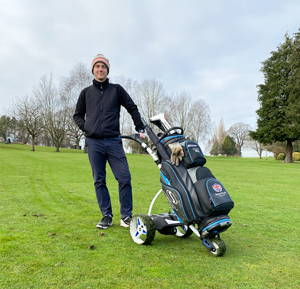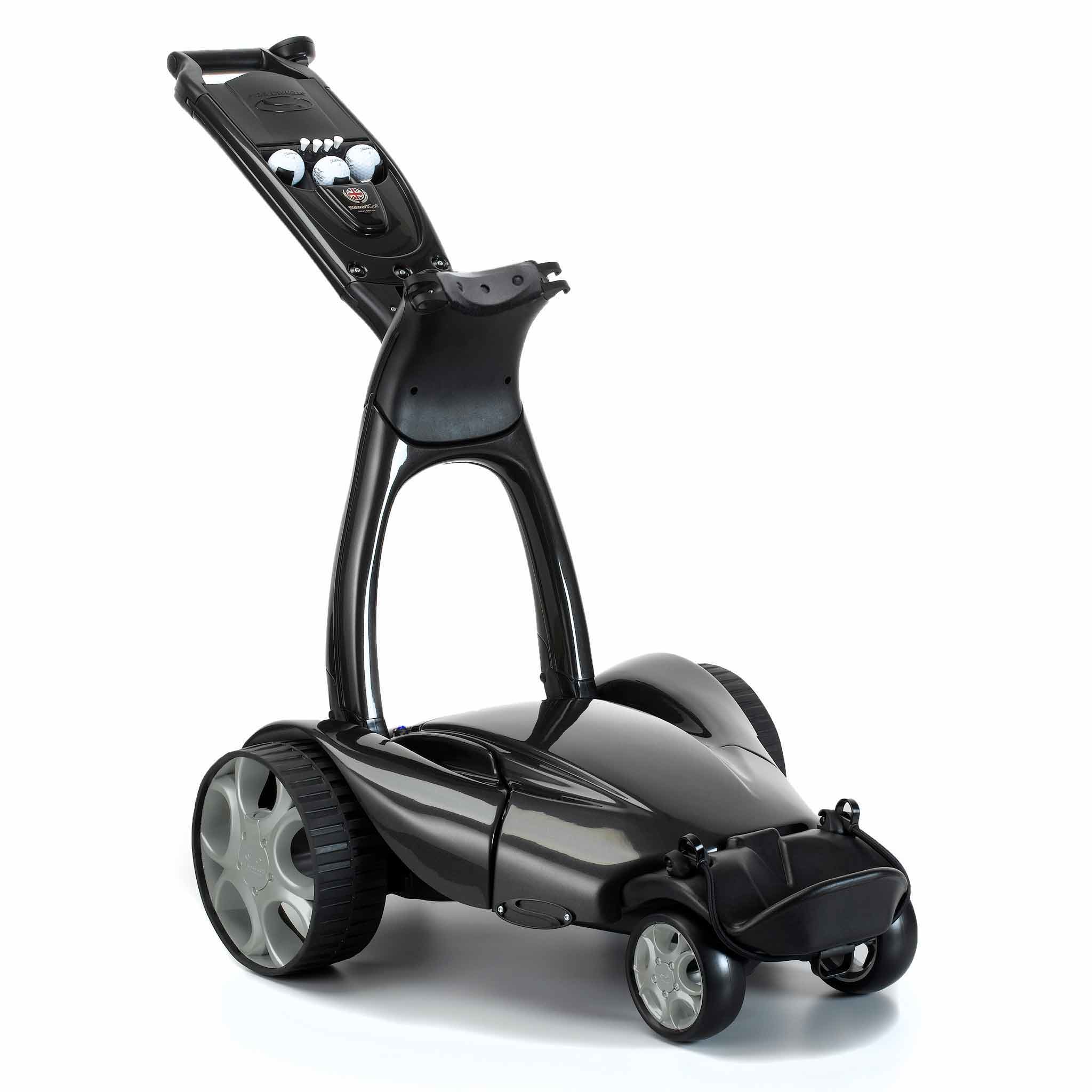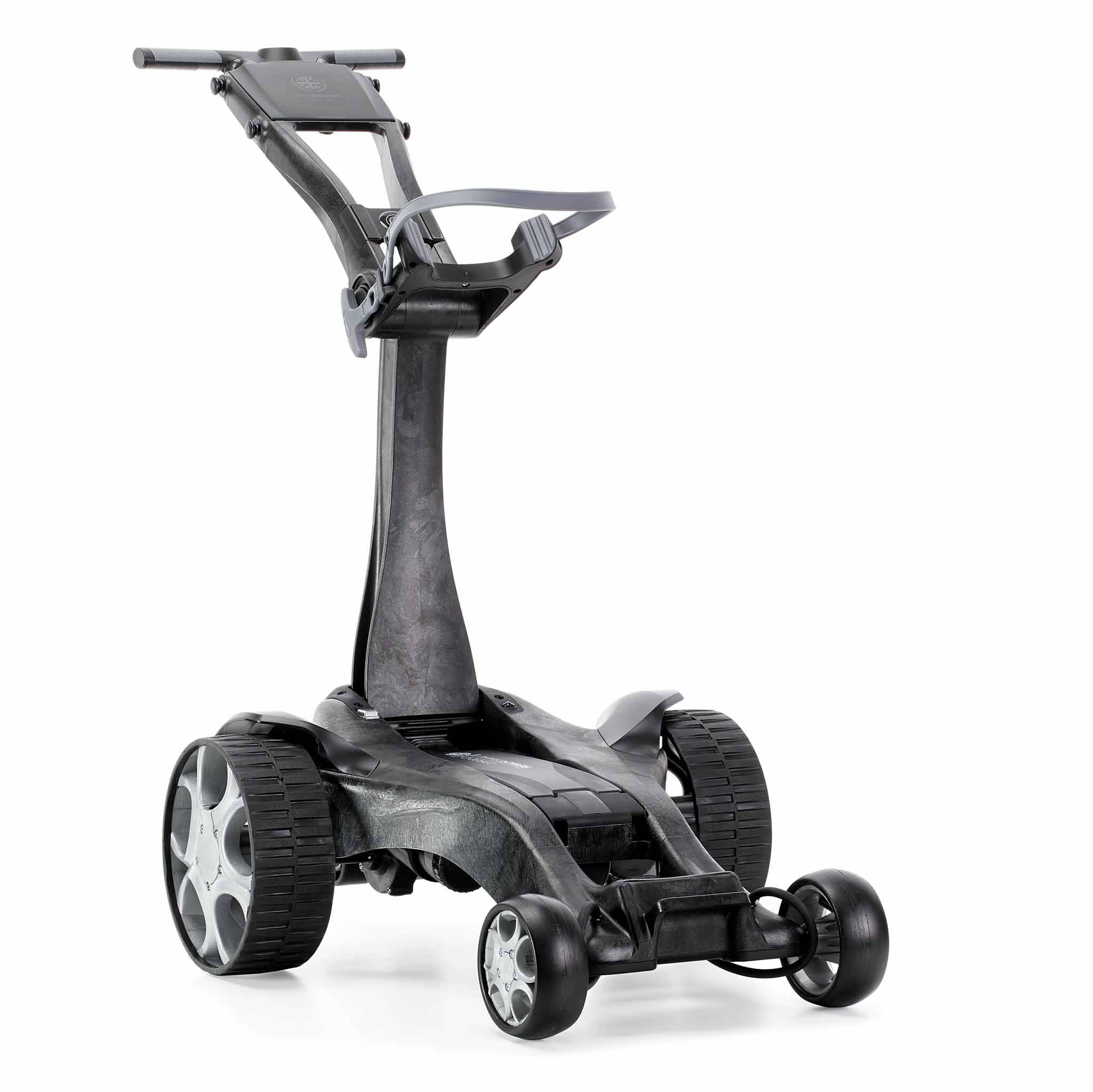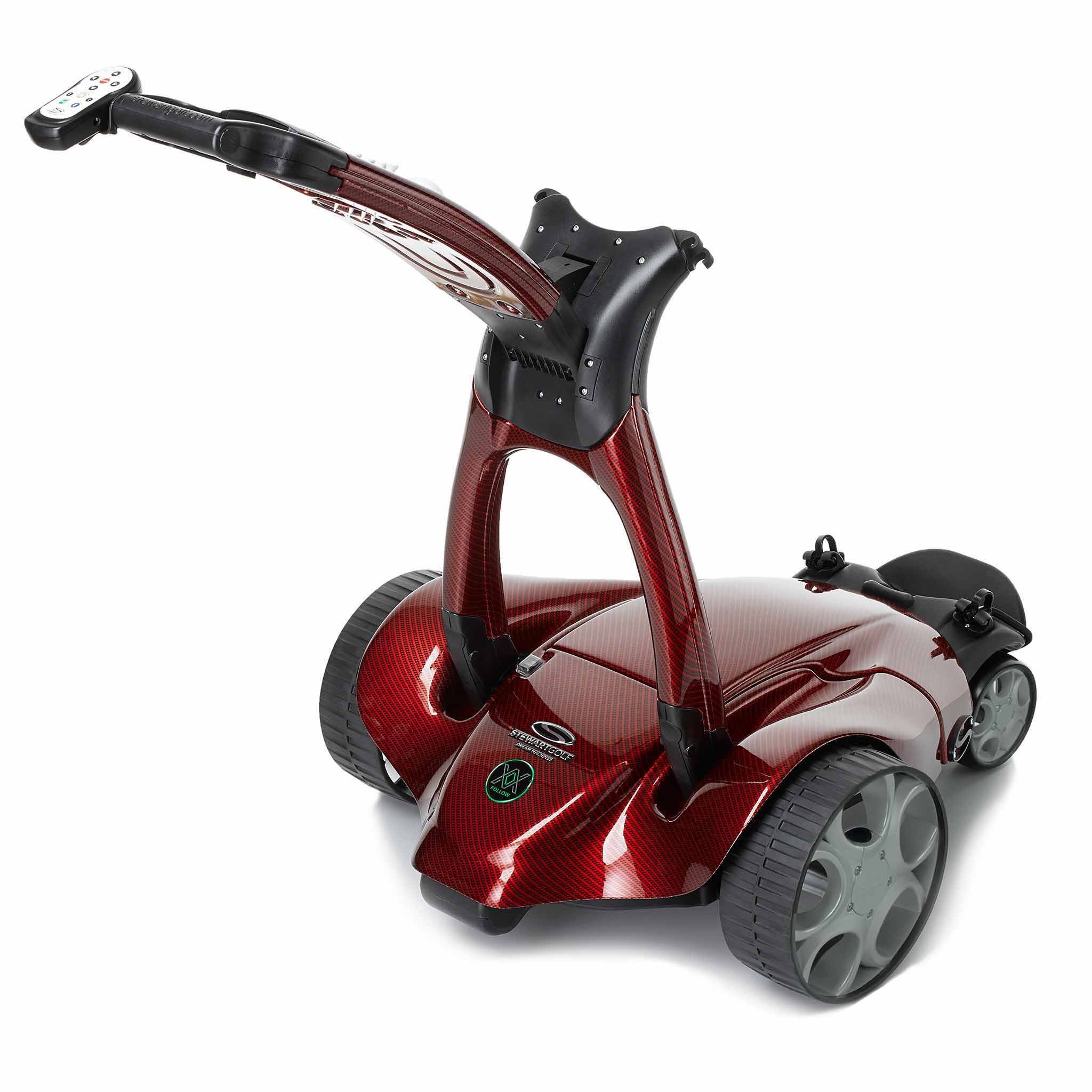"They say you don't miss things until they're gone. That was certainly the case for me playing my first ever round of golf with a conventional electric caddie."
It’s mid-January, the temperature is still below freezing as I pull up into the car park at Lilley Brook Golf Club in Cheltenham, England, for our latest morning of testing. This particular morning I’ve been given a leading conventional electric caddie to play with, instead of my own Q Follow. For you see, in my short 16-month golf journey to date, I’ve been lucky enough to transition from carrying my clubs to playing with a Stewart Golf Follow caddie. In doing so, I’ve never actually played a round with a conventional ‘remoteless’ electric caddie. So, I was heading into this round with no prior expectations or knowledge, and only a keen sense of intrigue as to how different my experience on the course could be without my Q.
As a team we regularly head out to one of our local courses with a selection of caddie models. For those like myself, who play regularly with my Q Follow, it’s an opportunity to experience how other caddies perform and how they contribute to your round. Whether this be one of our other models, or a leading alternative brand. For the non-golfers in the team it is invaluable time to get out and use our caddies, adding practical knowledge to their expertise. Of course, it also gives us the chance to test latest updates, new technologies and model variations, before we incorporate them into our production line.
And so, with one final blast of the car’s heating, my test began. The first thing I noted about the caddie was that it was incredibly light and just as easy to assemble out of the car as my Q. The skeletal, bare-bones design ensures that the battery does not need much power to push the caddie along, and that was reflected in being able to easily pluck it out of the trunk one-handed. I must say, for such a minimal design it did take up a considerable amount of space in my car, as the front wheel does not fold down at all, leaving me with no option but to have both the back seats down.
With no previous knowledge or outside help from my playing partners, I was able to quickly get my head around the controls of the caddie and head off to the first tee, desperately wishing I had remembered to bring my winter gloves with me. On the course it didn’t take long for me to have my first taste of missing my Q Follow. A pulled tee shot – typical of my 19.5 handicap - saw me head towards the trees whilst my partners carried on our conversation. In a normal round with my Q Follow I’m able to send my caddie to my ball while continuing my sociable round of golf or even help look for a partner’s lost ball, knowing I’m in place ready to take my shot when I need to. Without the remote option, I experienced the pressures of keeping up with play more and in doing so certainly felt like I lost a bit of that social aspect of my round.
Our Electric Caddies

I must admit I don’t tend to pay much attention to the pedometer on my golf watch, although I’d be confident in betting that my round included a significant amount more steps, compared to my average. Using my Q Follow, I no longer have to go back on myself and pick up my clubs. Finishing on the green, my caddie is waiting for me at the next tee. Searching for a ball in the rough, my Q comes to meet me on the edge. Play my drive and we leave the tee box together. As individual moments one might call it being lazy, but over the course of 18 holes it all adds up, if not from a physical point of view, then certainly from a mental one. Come the final two or three holes that perceived bit of extra energy can make all the difference.
I must admit I don’t tend to pay much attention to the pedometer on my golf watch, although I’d be confident in betting that my round included a significant amount more steps, compared to my average. Using my Q Follow, I no longer have to go back on myself and pick up my clubs. Finishing on the green, my trolley is waiting for me at the next tee. Searching for a ball in the rough, my Q comes to meet me on the edge.
I must admit I don’t tend to pay much attention to the pedometer on my golf watch, although I’d be confident in betting that my round included a significant amount more steps, compared to my average. Using my Q Follow, I no longer have to go back on myself and pick up my clubs. Finishing on the green, my trolley is waiting for me at the next tee. Searching for a ball in the rough, my Q comes to meet me on the edge.

I must admit I don’t tend to pay much attention to the pedometer on my golf watch, although I’d be confident in betting that my round included a significant amount more steps, compared to my average. Using my Q Follow, I no longer have to go back on myself and pick up my clubs. Finishing on the green, my trolley is waiting for me at the next tee. Searching for a ball in the rough, my Q comes to meet me on the edge.
Play my drive and we leave the tee box together. As individual moments one might call it being lazy, but over the course of 18 holes it all adds up, if not from a physical point of view, then certainly from a mental one. Come the final two or three holes that perceived bit of extra energy can make all the difference.
I must admit I don’t tend to pay much attention to the pedometer on my golf watch, although I’d be confident in betting that my round included a significant amount more steps, compared to my average. Using my Q Follow, I no longer have to go back on myself and pick up my clubs. Finishing on the green, my trolley is waiting for me at the next tee. Searching for a ball in the rough, my Q comes to meet me on the edge. Play my drive and we leave the tee box together. As individual moments one might call it being lazy, but over the course of 18 holes it all adds up, if not from a physical point of view, then certainly from a mental one. Come the final two or three holes that perceived bit of extra energy can make all the difference.
I must admit I don’t tend to pay much attention to the pedometer on my golf watch, although I’d be confident in betting that my round included a significant amount more steps, compared to my average. Using my Q Follow, I no longer have to go back on myself and pick up my clubs. Finishing on the green, my trolley is waiting for me at the next tee. Searching for a ball in the rough, my Q comes to meet me on the edge.
I must admit I don’t tend to pay much attention to the pedometer on my golf watch, although I’d be confident in betting that my round included a significant amount more steps, compared to my average. Using my Q Follow, I no longer have to go back on myself and pick up my clubs. Finishing on the green, my trolley is waiting for me at the next tee. Searching for a ball in the rough, my Q comes to meet me on the edge.
Play my drive and we leave the tee box together. As individual moments one might call it being lazy, but over the course of 18 holes it all adds up, if not from a physical point of view, then certainly from a mental one. Come the final two or three holes that perceived bit of extra energy can make all the difference.
Play my drive and we leave the tee box together. As individual moments one might call it being lazy, but over the course of 18 holes it all adds up, if not from a physical point of view, then certainly from a mental one. Come the final two or three holes that perceived bit of extra energy can make all the difference.
As I make my way across the still frosted course, I couldn’t help but notice the performance of the wheels on the solid, frozen ground. This lightweight trolley (with the standard set of wheels), on numerous occasions would skid and spin on the ground with little to no traction, resulting in me pushing the trolley along like a sled for a meter or two before re-engaging. Thankfully, even with a full bag the trolley really doesn’t weigh much and I could move it along with minimal effort.
After a very lackluster start on the temporary greens, my golf had started to pick up and by the time we headed for the turn I was back on bogey golf. I had grown comfortable with the trolley, yet still couldn’t help but compare it to my usual equipment, the lack of remote and thus shortage of control and freedom was all too evident. I’ve got so used to sending my trolley off ahead or have it following behind me, out of sight and mind. That now, with a playing companion that only ever went where I went, I felt tethered, inconvenienced almost. In fairness, the trolley wasn’t doing anything wrong, it wasn’t making my round less enjoyable or harder than if I were carrying or using a push trolley. But it wasn’t making it more enjoyable, it wasn’t adding anything to my experience, and on the flat front nine I was failing to see the real benefit of this electric trolley over a good push trolley.
The benefits did however reveal themselves on the back nine. As we turned the corner, so did the terrain change from frost covered flat ground, to sun-drenched hillside. As we made our way further up the hills, I was certainly happy to have the assistance of my electric trolley, despite there still being some fiddly back and forth with the speed dial to continuously match my pace. All-in-all the trolley made light work of the steep uphill walk and helped me save energy heading into the final holes.
As I made my way across the still frosted course, I couldn’t help but notice the performance of the wheels on the solid, frozen ground. This lightweight caddie (with the standard set of wheels), on numerous occasions would skid and spin on the ground with little to no traction, resulting in me pushing the caddie along like a sled for a meter or two before re-engaging. Thankfully, even with a full bag the caddie really doesn’t weigh much and I could move it along with minimal effort.
After a very lackluster start on the temporary greens, my golf had started to pick up and by the time we headed for the turn I was back on bogey golf. I had grown comfortable with the caddie, yet still couldn’t help but compare it to my usual equipment, the lack of remote and thus shortage of control and freedom was all too evident. I’ve got so used to sending my caddie off ahead or have it following behind me, out of sight and mind. Now, with a playing companion that only ever went where I went, I felt tethered, inconvenienced almost. In fairness, the caddie wasn’t doing anything wrong, it wasn’t making my round less enjoyable or harder than if I were carrying or using a push cart. But it wasn’t making it more enjoyable, it wasn’t adding anything to my experience, and on the flat front nine I was failing to see the real benefit of this electric caddie over a good push cart.
The benefits did however reveal themselves on the back nine. As we turned the corner, so did the terrain change from frost covered flat ground, to sun-drenched hillside. As we made our way further up the hills, I was certainly happy to have the assistance of my electric caddie, despite there still being some fiddly back and forth with the speed dial to continuously match my pace. All-in-all the caddie made light work of the steep uphill walk and helped me save energy heading into the final holes.
Whilst heading uphill was proving to be the caddie's best attribute, it was less impressive on the downhill slope and travelling across horizontal slopes. In both such instances I was left fighting with gravity to stop a runaway caddie. On the horizontal slope I found myself having to keep one hand on the side of my bag as I walked for fear of the whole thing toppling over. Suddenly the lightweight frame didn’t seem such a benefit and with a narrow wheelbase the caddie really struggled over this type of ground. Downhill was a similar beast, with no braking system, either manual or mechanic, it was down to me to keep the caddie from rolling away, just as if I were playing with a push cart. During shots I had to rely on my playing partners to hold my caddie and stop it from ending up at the bottom of the hill. In all, I found the whole process a bit of a distraction, and whilst it would be very easy to blame this for my score on the back nine, it certainly didn’t help when it came to focusing on the task at hand.
After a rare, straight drive down the 18th and another steep downhill to negotiate, my first ever round with a conventional electric caddie drew to a close. “So, what did you think?” asked my playing partners. My answer? I suppose it is all relative to what you are comparing it with. Did it come close to the experience of playing with my Q Follow? I can say with all honesty, no. Did it improve upon carrying my clubs, yes it did, but shouldn’t that be a given?
In fact, what I would say is, that playing golf with the conventional caddie was less like an electric caddie experience and more like using a ‘power assisted push cart’. For 90% of my round, it acted like a push cart, yes it didn’t involve much pushing, but I still had to keep hold of the caddie at all times and guide it by hand. Other than the assistance uphill there really wasn’t too much difference to the experience of using a push. That is until you compare the relative prices. Personally, I’d save the $700 and take the added strain up the hills.
I can see why someone looking to invest in their first electric caddie would look at these conventional electric caddies, and the very latest models do offer an automated feature where you can set your caddie to travel for a specific distance and send it on its way. But for me, the idea of the electric caddie is surely to give you less to worry about. As a self-proclaimed ‘bad golfer’ my head is full of different tips and advice I’m trying to remember before each swing, I don’t want to have to deal with a similar scenario as I ‘aim and fire’ my caddie down the fairway.
Roll on a few days and I was back out on the course, my Q Following me up the fairway as I attempted to unwrap an unseasonably early Easter egg. Now if that isn’t adding to your on course experience I don’t know what is!
Whilst heading uphill was proving to be the trolley’s best attribute, it was less impressive on the downhill slope and travelling across horizontal slopes. In both such instances I was left fighting with gravity to stop a runaway trolley. On the horizontal slope I found myself having to keep one hand on the side of my bag as I walked for fear of the whole thing toppling over. Suddenly the lightweight frame didn’t seem such a benefit and with a narrow wheelbase the trolley really struggled over this type of ground. Downhill was a similar beast, with no braking system, either manual or mechanic, it was down to me to keep the trolley from rolling away, just as if I were playing with a push trolley. During shots I had to rely on my playing partners to hold my trolley and stop it from ending up at the bottom of the hill. In all, I found the whole process a bit of a distraction, and whilst it would be very easy to blame this for my score on the back nine, it certainly didn’t help when it came to focusing on the task at hand.
After a rare, straight drive down the 18th and another steep downhill to negotiate, my first ever round with a conventional electric trolley drew to a close. “So, what did you think?” asked my playing partners. My answer? I suppose it is all relative to what you are comparing it with. Did it come close to the experience of playing with my Q Follow? I can say with all honesty, no. Did it improve upon carrying my clubs, yes it did, but shouldn’t that be a given?
In fact, what I would say is, that playing golf with the conventional trolley was less like an electric trolley experience and more like using a ‘power assisted push trolley’. For 90% of my round, it acted like a push trolley, yes it didn’t involve much pushing, but I still had to keep hold of the trolley at all times and guide it by hand. Other than the assistance uphill there really wasn’t too much difference to the experience of using a push. That is until you compare the relative prices. Personally, I’d save the $700 and take the added strain up the hills.
I can see why someone looking to invest in their first electric trolley would look at these conventional electric trolleys, and the very latest models do offer an automated feature where you can set your trolley to travel for a specific distance and send it on its way. But for me, the idea of the electric trolley is surely to give you less to worry about. As a self-proclaimed ‘bad golfer’ my head is full of different tips and advice I’m trying to remember before each swing, I don’t want to have to deal with a similar scenario as I ‘aim and fire’ my trolley down the fairway.
Roll on a few days and I was back out on the course, my Q Following me up the fairway as I attempted to unwrap an unseasonably early Cadbury crème egg. Now if that isn’t adding to your on course experience I don’t know what is!








